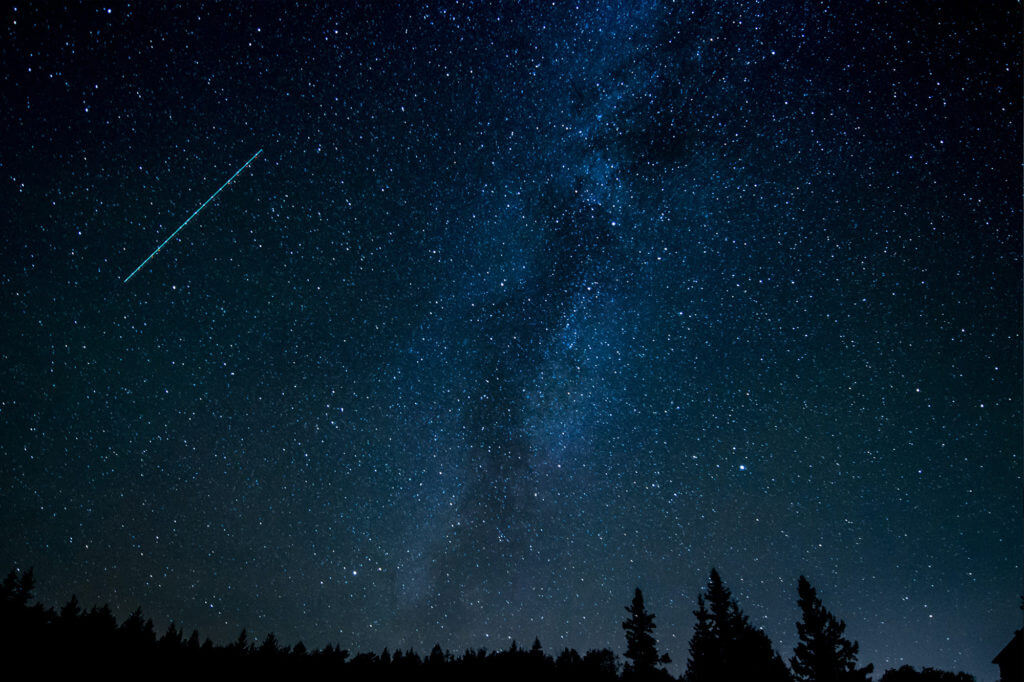Peak Stargazing Nights
July 28, 2021 @ 12:00 am - July 29, 2021 @ 5:00 am
One event on August 12, 2021 at 12:00am
One event on September 14, 2021 at 12:00am
One event on October 7, 2021 at 12:00am
One event on October 21, 2021 at 12:00am
One event on October 22, 2021 at 12:00am
One event on November 19, 2021 at 12:00am
One event on December 13, 2021 at 12:00am
One event on December 14, 2021 at 12:00am
One event on December 21, 2021 at 12:00am
One event on December 22, 2021 at 12:00am
Family Fun, Nightlife, Nature

- This event has passed.
Event Navigation

Look to the sky on these dates for Self-Guided Stargazing!
A dark, quiet night is the perfect time to sit back, look up, and enjoy the mesmerizing star-studded skies. While being tucked away in the Colorado Rocky Mountains, the Ranch has very little light pollution creating the ideal setting for stargazing and experiencing the most magical meteor showers and comet sightings.
DELTA AQUARIIDS METEOR SHOWER
July 28–29
Produced by debris left behind by comets Marsden and Kracht, this shower can produce up to 20 meteors per hour at its peak. Running annually from July 12 to August 23, it peaks this year on the night of July 28 and the morning of July 29. The best viewing will be from a dark location after midnight. Meteors will radiate from the constellation Aquarius but can appear anywhere in the sky.
PERSEIDS METEOR SHOWER
August 12–13
Considered one of the best meteor showers of the year, this shower produces up to 60 meteors per hour at its peak. The waxing crescent moon will set early in the evening, leaving dark skies for what should be an excellent show. The best viewing will be from a dark location after midnight. Meteors will radiate from the constellation Perseus but can appear anywhere in the sky.
NEPTUNE AT OPPOSITION
September 14
The Blue Giant planet will be at its closest approach to earth and its face will be fully illuminated by the sun. It will be brighter than any other time of the year and will be visible all night long. This is the best time to view and photograph Neptune. Due to its extreme distance from earth, it will only appear as a tiny blue dot in all but the most powerful telescopes.
DRACONIDS METEOR SHOWER
October 7
The Draconids is a minor meteor shower, producing only about 10 meteors per hour. It is produced by dust grains left behind by comet 21P Giacobini-Zinner, which was first discovered in 1900. The Draconids is an unusual shower in that the best viewing is in the early evening instead of early morning like most other showers. The shower runs annually from October 6-10 and peaks this year on the night of the 7th. This year, the nearly new moon will leave dark skies for what should be an excellent show. Meteors will radiate from the constellation Draco but can appear anywhere in the sky.
ORIONIDS METEOR SHOWER
October 21–22
The Orionids is an average shower producing up to 20 meteors per hour at its peak. It peaks this year on the night of October 21 and the morning of October 22. The full moon will be a problem this year for the Orionids. Its glare will block out all but the brightest meteors. But if you are patient, you should still be able to catch a few good ones. The best viewing will be from a dark location after midnight. Meteors will radiate from the constellation Orion but can appear anywhere in the sky.
PARTIAL LUNAR ECLIPSE
November 19
A partial lunar eclipse occurs when the Moon passes through the Earth’s partial shadow or penumbra, and only a portion of it passes through the darkest shadow or umbra. During this type of eclipse, a part of the Moon will darken as it moves through the Earth’s shadow.
GEMINIDS METEOR SHOWER
December 13–14
The Geminids is the king of the meteor showers. It is considered by many to be the best shower in the heavens, producing up to 120 multicolored meteors per hour at its peak. It is produced by debris left behind by an asteroid known as 3200 Phaethon, which was discovered in 1982. The shower runs annually from December 7-17. It peaks this year on the night of the 13th and morning of the 14th. The waxing gibbous moon will block out most of the fainter meteors this year. But the Geminids are so numerous and bright that this could still be a good show. The best viewing will be after midnight.
DECEMBER SOLSTICE
December 21
The South Pole of the earth will be tilted towards the sun, which will have reached its southernmost position in the sky and will be directly over the Tropic of Capricorn at 23.44 degrees south latitude. This is the first day of winter (winter solstice) in the Northern Hemisphere and the first day of summer (summer solstice) in the Southern Hemisphere.
URSIDS METEOR SHOWER
December 21–22
The Ursids is a minor meteor shower producing about 5-10 meteors per hour. The nearly full moon will be a problem this year, blocking all but the brightest meteors. But if you are patient enough, you may still be able to catch a few good ones. The best viewing will be just after midnight from a dark location. Meteors will radiate from the constellation Ursa Minor but can appear anywhere in the sky.